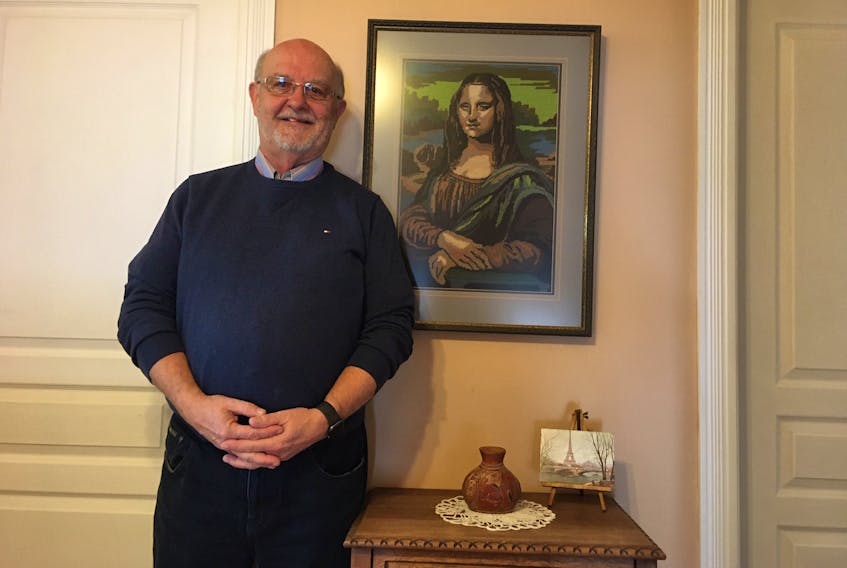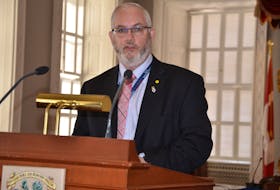It’s been 13 months since Harold Hefferton had to move his 68-year-old wife, Barbara, into a St. John’s long-term care facility.
Her Alzheimer’s disease had progressed, and she needed more care than Harold could provide at home.
He found himself going from husband to caretaker to advocate, and was wracked with guilt and grief.

If learning your spouse has dementia is like being strapped into a roller-coaster ride and shoved forward, with life suddenly out of kilter, nowadays Harold is feeling less like he could be thrown; he has a better grip on things and sees the track ahead more clearly.
He’s still an advocate, and he also feels more like a husband again.
He’s taking better care of himself. His eyes are happier; less haunted. He walks regularly and is trimmer.
Indeed, wearing a reflective vest, he walked the nine-kilometre return trip to see Barbara every day during the recent state of emergency in St. John’s.
But then he’s always been willing to go the distance.
After they met in 1968, he would drive 689 kilometres from St. John’s to Corner Brook in his Volkswagen Beetle to see her on weekends.

“So where is she now, a year later?” says Harold, 71, in response to my questions.
“She’s lost about 60 pounds. The disease has tightened its grip. There’s the loss of weight, the lack of desire to eat, the agitation that goes with the disease.… She knows me, but there could be two of me in the room; there’s a certain amount of hallucination, less cognitive moments.”
On days when Barbara is agitated and nothing seems to give her comfort, it is easier for him to accept that long-term care was the best option for the love of his life, though that decision was torturous. But there are sunnier days, too.
“She still likes to listen to Rod Stewart and Johnny Reid. When I go in to visit I’ll act foolish and dance around the room, and that usually works — it brings a smile to her face,” he says.
He’s grateful to have found a licensed practical nurse who, during her time off, provides one-on-one care to Barbara.
“We call it Barb’s ‘spa day,’” he said. “She does her nails and stuff.”
As for his own therapy, staying busy keeps him motivated and on an even keel.
He’s on the boards of the St. John’s Port Authority and Anglican Homes Inc.
He’s also a director with the Alzheimer Society of Newfoundland and Labrador, he’s an ambassador for Alzheimer Society of Canada’s “I Live with Dementia” program, and he’s an adviser with Eastern Health’s Client Focus Group as well as its Client and Family Centred Care steering committee.
“I’m in a much better place now,” he says. “The psychological term is compartmentalizing. That’s why I say I’m living two different lives. … Doing this work… I’m advocating first and foremost for my wife, but I’m also advocating for everyone. … I’m enjoying my life to the extent that one can with a loved one living in a long-term care facility, especially your spouse.
“Nighttime I miss her most. … It’s at the end of the day, the ‘How was your day’ discussions. The fights and the making up — that was the best part. Talking about your grandchildren, planning trips.”
“I’m in a much better place now,” he says. “The psychological term is compartmentalizing. That’s why I say I’m living two different lives. …" — Harold Hefferton
A few years after Barbara was diagnosed, he remembers walking into the room at the tail end of a TV report about Alzheimer’s that she was listening to.
“She looked up with tears in her eyes and said, ‘Maybe someday there will be a cure.’”
For now, he’ll keep sharing their experience and encouraging others to talk and reach out for support.
And he’ll find joyous moments with Barbara, especially those times when she seems fully with him, however fleetingly.
“One day she was agitated and a careworker was there, and her sister. I arrived and cuddled her, and she said, ‘My husband is here now, I’m all right.’
“There are breakthroughs,” Harold says quietly. “The disease won’t win. Love will win out in the end.”
Pam Frampton is The Telegram’s managing editor. Email [email protected]. Twitter: pam_frampton
RELATED COLUMNS FROM PAM FRAMPTON
• Harold and Barbara — a fork in the road
• Harold and Barbara — two lives in the balance









